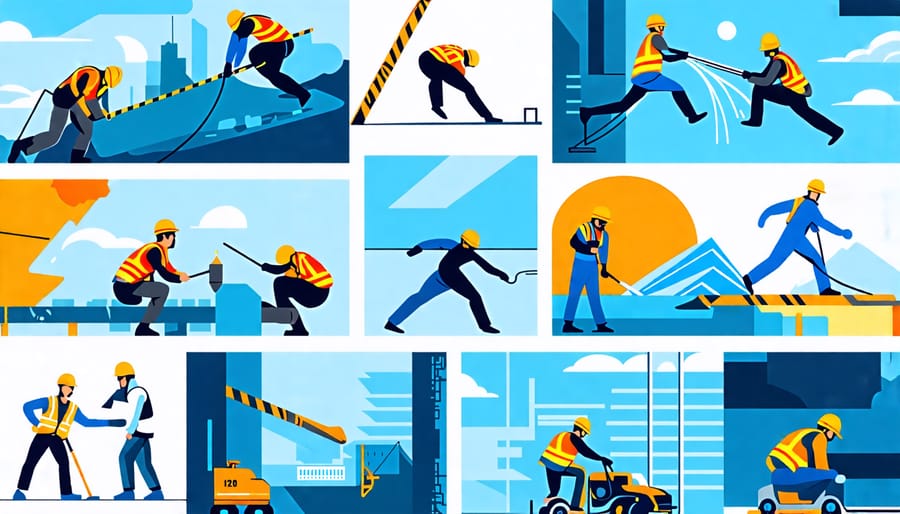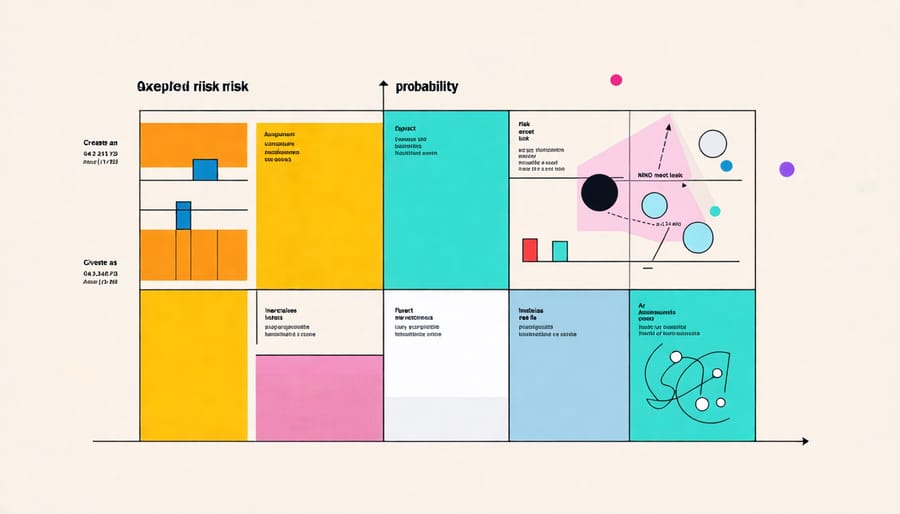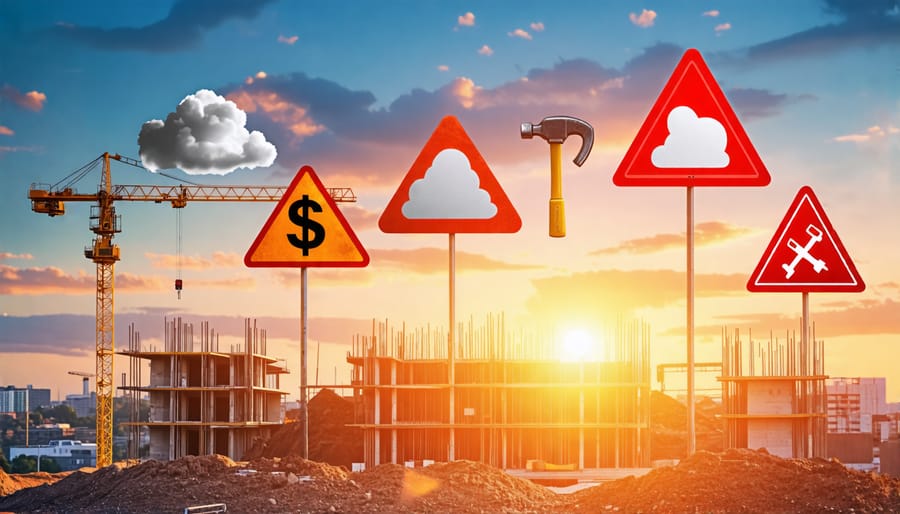Identify and assess potential risks early in the project planning phase. Engage all stakeholders, including the client, design team, contractors, and subcontractors, to comprehensively map out risks across all aspects of the construction project. Categorize risks based on their likelihood and potential impact, prioritizing those that could significantly derail the project timeline, budget, or quality.
Develop a clear risk mitigation strategy for each identified risk. Assign specific actions to be taken, resources required, and personnel responsible for implementing the mitigation measures. This may include securing additional insurance coverage, allocating contingency funds, or creating backup plans for critical materials or equipment.
Establish open and transparent communication channels among all project stakeholders. Regular risk management meetings should be held to review the status of identified risks, assess the effectiveness of mitigation strategies, and identify any new risks that may have emerged. Encourage a culture of proactive risk reporting and collaboration to ensure that potential issues are addressed promptly.
Continuously monitor and review the risk management plan throughout the construction process. As the project progresses, regularly update the plan to reflect any changes in circumstances, new risks identified, or mitigation strategies that need to be adapted. Treat the risk management plan as a living document that evolves alongside the project, ensuring that it remains relevant and effective in safeguarding the project’s success.
Identify and Assess Risks
Common Construction Risks
Construction projects face a multitude of risks that can impact timelines, budgets, and overall project success. One of the most critical risks is safety hazards, which can lead to worker injuries or fatalities if not properly addressed. Weather delays are another common risk, as extreme conditions like heavy rain, snow, or high winds can halt construction progress. Material shortages can also cause significant setbacks, especially if the required materials are rare or in high demand. Other potential risks include design defects, equipment failures, labor disputes, and unexpected site conditions such as underground utilities or soil contamination. Financial risks, including cost overruns, insufficient funding, and client payment delays, can also jeopardize a project’s viability. Additionally, legal and regulatory compliance issues, such as permit delays or environmental concerns, can lead to costly fines and project delays. By identifying and assessing these common risks early in the planning process, construction teams can develop targeted strategies to mitigate their impact and ensure a smoother, more successful project delivery.

Prioritizing Risks
To effectively manage construction risks, prioritizing them based on their likelihood and potential impact is crucial. Risk matrices and heat maps are valuable tools for visualizing and ranking risks. These tools typically categorize risks on a scale from low to high probability and low to high impact.
When assessing likelihood, consider factors such as past project data, industry trends, and expert opinions. Evaluate the probability of each risk occurring within the project timeline. Impact, on the other hand, refers to the severity of consequences if the risk materializes. This may include financial losses, schedule delays, safety incidents, or reputational damage.
By plotting risks on a matrix or heat map, construction professionals can quickly identify high-priority risks that require immediate attention and proactive mitigation strategies. Risks falling into the high-probability, high-impact quadrant should be addressed first, as they pose the greatest threat to project success.
Medium-priority risks, with either high probability and low impact or low probability and high impact, should be closely monitored and managed through contingency plans. Low-priority risks, characterized by low probability and low impact, may require minimal intervention but should still be periodically reviewed.
Regularly updating and reviewing the risk matrix throughout the project lifecycle is essential, as risks can evolve and new ones may emerge. By prioritizing risks effectively, construction teams can allocate resources efficiently and implement targeted risk management strategies to minimize potential disruptions and ensure project success.

Develop Risk Mitigation Strategies
After identifying potential risks, construction teams must develop targeted strategies to prevent these risks from occurring or minimize their impact if they do occur. One common risk mitigation strategy is to transfer risk through insurance policies or contractual agreements with subcontractors and suppliers. This shifts some financial responsibility to other parties in case issues arise.
Another effective approach is to implement rigorous quality control measures throughout the project lifecycle. For example, a high-rise construction project in New York City avoided costly delays by conducting regular inspections and catching potential defects early. The team also invested in advanced modeling software to identify design clashes before construction began, preventing expensive rework later.
Contingency planning is another critical risk mitigation tool. By anticipating worst-case scenarios and developing backup plans, teams can respond quickly if problems occur. A hospital expansion project in California created a detailed contingency plan for potential supply chain disruptions, allowing them to source alternative materials without derailing the schedule when their primary supplier experienced a shortage.
Ongoing communication and collaboration among all project stakeholders is also essential for mitigating risks. Regular meetings to discuss progress, challenges, and solutions keep everyone informed and aligned. A airport renovation project team held daily stand-up meetings and used cloud-based collaboration software to ensure real-time information sharing, helping them navigate complexities and make swift decisions to keep the project on track.
By proactively implementing these risk mitigation strategies and fostering a risk-aware culture, construction teams can significantly reduce the likelihood and impact of potential issues, ultimately delivering projects on time, within budget, and to the required quality standards.
Assign Roles and Responsibilities
Assigning clear roles and responsibilities is a critical component of an effective construction risk management plan. By defining who is accountable for each aspect of risk management, the project team can ensure that potential issues are identified, assessed, and mitigated in a timely manner. The project manager should work closely with the risk manager to delegate these responsibilities across the team, taking into account each member’s expertise and capacity.
The risk manager plays a central role in overseeing the entire risk management process. Their duties include developing and implementing the risk management plan, identifying and assessing potential risks, recommending mitigation strategies, and monitoring the effectiveness of these measures throughout the project lifecycle. The risk manager should also be responsible for communicating risk-related information to the project team, stakeholders, and senior management, ensuring that everyone is aware of the current risk landscape and any actions being taken to address concerns.
In addition to the risk manager, other team members should be assigned specific risk management tasks based on their roles and areas of expertise. For example, the site supervisor may be responsible for identifying and reporting safety hazards, while the procurement manager may be tasked with assessing and mitigating supply chain risks. By distributing risk management responsibilities across the team, the project can benefit from a diverse range of perspectives and ensure that risks are addressed in a comprehensive manner.
Establish Monitoring and Reporting Protocols
To effectively manage risks throughout the construction project lifecycle, it’s crucial to establish robust monitoring and reporting protocols. Continuous risk monitoring involves regularly reviewing identified risks, assessing their potential impact, and updating risk registers accordingly. This proactive approach enables project teams to stay ahead of emerging issues and make informed decisions.
One essential tool for monitoring risks is a comprehensive risk register. This centralized document should capture all identified risks, along with their likelihood, potential impact, and mitigation strategies. Regularly updating the risk register ensures that all stakeholders have access to the most current information and can collaborate on risk management efforts.
In addition to the risk register, project teams should establish clear reporting channels to facilitate timely communication about risks. This may include regular status reports, which provide an overview of the project’s progress, highlight any new or escalated risks, and outline the steps being taken to address them. These reports should be shared with all relevant stakeholders, including the project owner, design team, and subcontractors.
To streamline risk reporting, consider leveraging digital tools and platforms. Risk management software can automate many aspects of the reporting process, enabling real-time updates and ensuring that all team members have access to the same information. These tools can also generate visual dashboards and analytics, making it easier to track risk trends and identify areas that require additional attention.
By establishing strong monitoring and reporting protocols, construction teams can proactively manage risks, minimize surprises, and keep projects on track for success. Regular communication and collaboration are key to effective risk management, ensuring that all stakeholders are aligned and working towards a common goal.
Create Contingency Plans
Creating contingency plans is a crucial part of an effective construction risk management strategy. Even with the most thorough risk identification and mitigation efforts, some risks can still occur. Having well-defined contingency plans in place allows project teams to respond quickly and effectively when issues arise, minimizing their impact on the project’s timeline, budget, and quality.
To develop effective contingency plans, start by prioritizing the identified risks based on their likelihood and potential impact. Focus on high-priority risks that could significantly affect the project’s success. Next, collaborate with your team to brainstorm potential solutions and alternative approaches for each prioritized risk. Consider the resources, time, and costs associated with each solution, and assess their feasibility within the project’s constraints.
Once you have identified the most appropriate solutions, document the contingency plans in detail. Clearly outline the triggers that would activate each plan, the specific actions to be taken, the responsible parties, and the expected outcomes. Ensure that all relevant stakeholders, including the project team, clients, and suppliers, are aware of the contingency plans and their roles in executing them.
It’s essential to review and update the contingency plans regularly throughout the project lifecycle. As new risks emerge or project circumstances change, adapt the plans accordingly. Continuously monitor the project’s progress and be prepared to implement the contingency plans when necessary.
Effective contingency planning also involves setting aside adequate resources, such as time, budget, and personnel, to handle potential issues. Consider establishing a contingency fund to cover unexpected costs associated with implementing the plans. By proactively allocating resources for contingencies, you can minimize the financial impact of risks on the project.
Remember, the goal of contingency planning is not to eliminate risks entirely but to have a well-defined course of action ready when they occur. By developing comprehensive contingency plans and communicating them clearly to all stakeholders, construction professionals can enhance their risk management capabilities and increase the likelihood of project success.
Foster a Risk-Aware Culture
Fostering a risk-aware culture is a crucial aspect of effective construction risk management. To embed risk awareness into the project team, regular training sessions should be conducted, covering topics such as identifying potential risks, assessing their impact, and implementing mitigation strategies. These sessions not only equip team members with the necessary skills but also reinforce the importance of proactive risk management.
Open communication is another key strategy for promoting a risk-aware culture. Encouraging team members to openly discuss potential risks, share their concerns, and collaborate on solutions creates an environment where risk management is a shared responsibility. Regular team meetings, as well as informal discussions, provide opportunities for this exchange of ideas and experiences.
By cultivating a proactive mindset, construction teams can reap significant benefits. When risk awareness is ingrained in the team culture, potential issues are identified and addressed early, minimizing their impact on the project. This proactive approach helps to prevent costly delays, rework, and safety incidents. Moreover, a risk-aware culture fosters innovation, as team members are encouraged to think creatively about risk mitigation and develop novel solutions.
Ultimately, a risk-aware culture contributes to the overall success of construction projects. By empowering team members to take ownership of risk management and providing them with the necessary tools and support, project leaders can create a resilient and adaptable team that is well-equipped to navigate the challenges inherent in the construction industry.

Continuously Review and Improve
A construction risk management plan is not a static document; it should be continuously reviewed and improved throughout the project lifecycle. Regular reviews allow the project team to identify new risks, assess the effectiveness of mitigation strategies, and make necessary adjustments. These reviews should involve all key stakeholders, including the project manager, contractors, subcontractors, and client representatives.
One effective technique for continuous improvement is conducting post-project reviews. These reviews provide an opportunity to reflect on the successes and challenges of the project, identifying lessons learned that can be applied to future projects. By analyzing the risk management process, the team can pinpoint areas where the plan excelled and where it fell short. This valuable feedback can inform updates to the risk management plan template, ensuring that it remains a relevant and effective tool.
Continuous improvement also involves staying up-to-date with industry best practices and emerging trends. Construction professionals should actively seek out training and professional development opportunities to enhance their risk management skills. Attending industry conferences, workshops, and webinars can provide valuable insights and networking opportunities that can help refine the risk management approach.
Technology can also play a significant role in continuously improving the risk management plan. By leveraging project management software, construction teams can streamline risk tracking, monitoring, and reporting. These tools can provide real-time data and analytics, enabling proactive decision-making and risk mitigation. As technology advances, it is essential to evaluate and adopt solutions that can enhance the efficiency and effectiveness of the risk management process.
Ultimately, a commitment to continuous review and improvement is critical to the success of a construction risk management plan. By fostering a culture of learning, adaptability, and proactive risk management, construction teams can minimize the impact of risks and drive successful project outcomes.
Conclusion
In summary, the seven key components of an effective construction risk management plan are risk identification, risk assessment, risk mitigation strategies, risk allocation, risk monitoring, communication and reporting, and continuous improvement. By proactively incorporating these elements into your plan, you can significantly enhance your project’s resilience and minimize potential disruptions.
A well-crafted risk management plan empowers construction professionals to anticipate and address potential challenges before they escalate into major issues. By identifying risks early, assessing their likelihood and impact, and implementing targeted mitigation measures, you can safeguard your project’s timeline, budget, and overall success.
Moreover, effective communication and regular reporting ensure that all stakeholders remain informed and aligned throughout the project lifecycle. This transparency fosters collaboration and enables timely decision-making when faced with emerging risks or unforeseen circumstances.
Ultimately, embracing a proactive approach to risk management is not just a best practice; it is a critical success factor in today’s complex construction landscape. By investing time and resources into developing a comprehensive risk management plan, construction professionals can navigate uncertainties with greater confidence, deliver projects more efficiently, and establish a strong foundation for long-term success in the industry.

